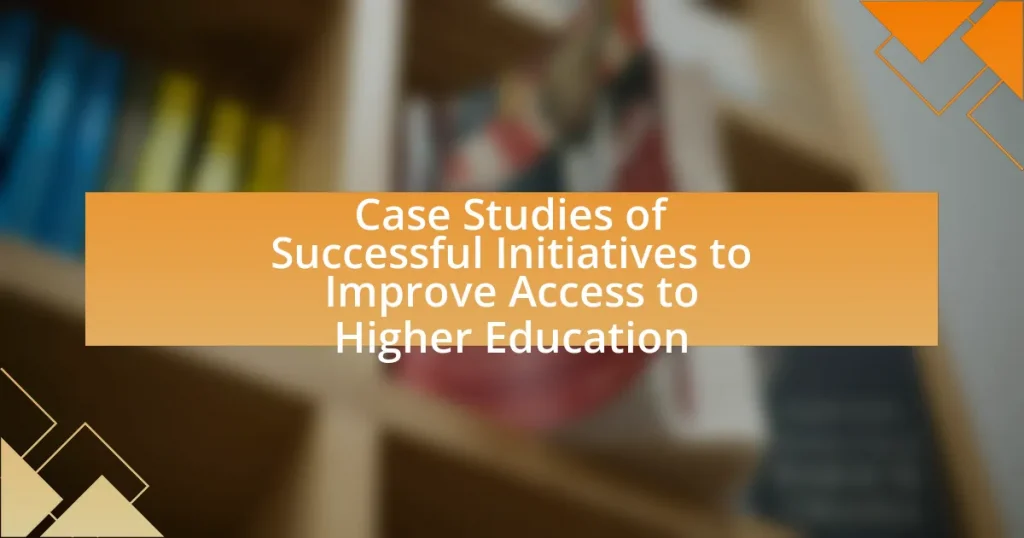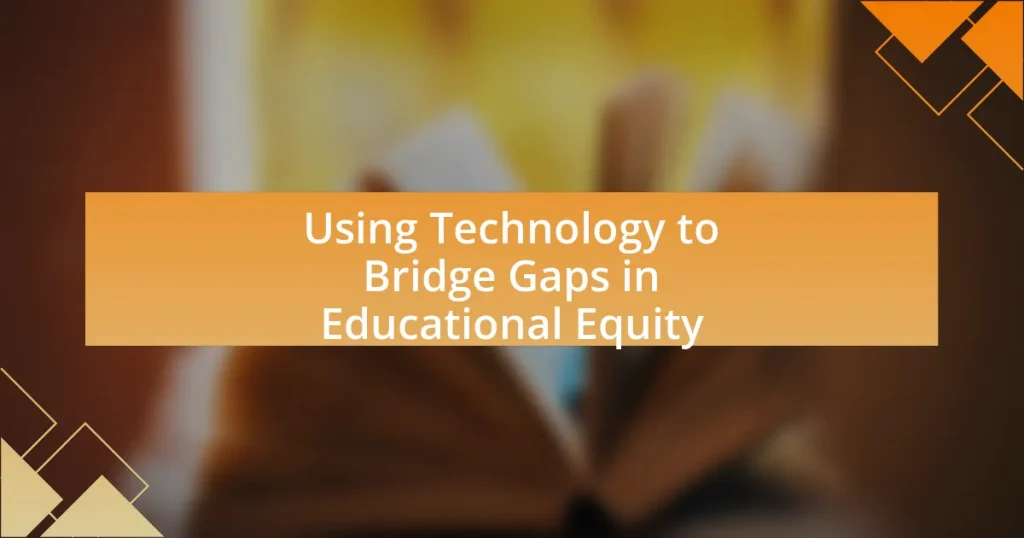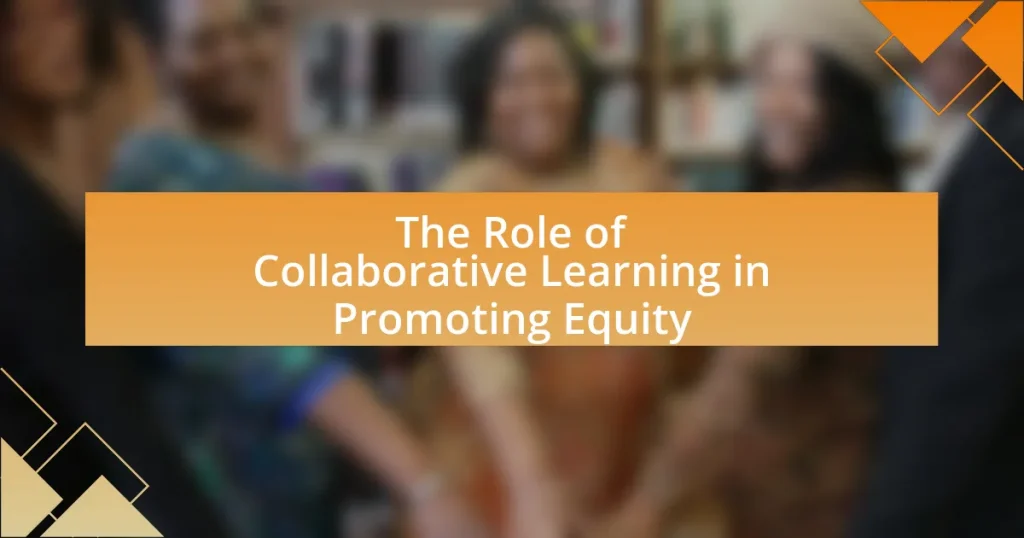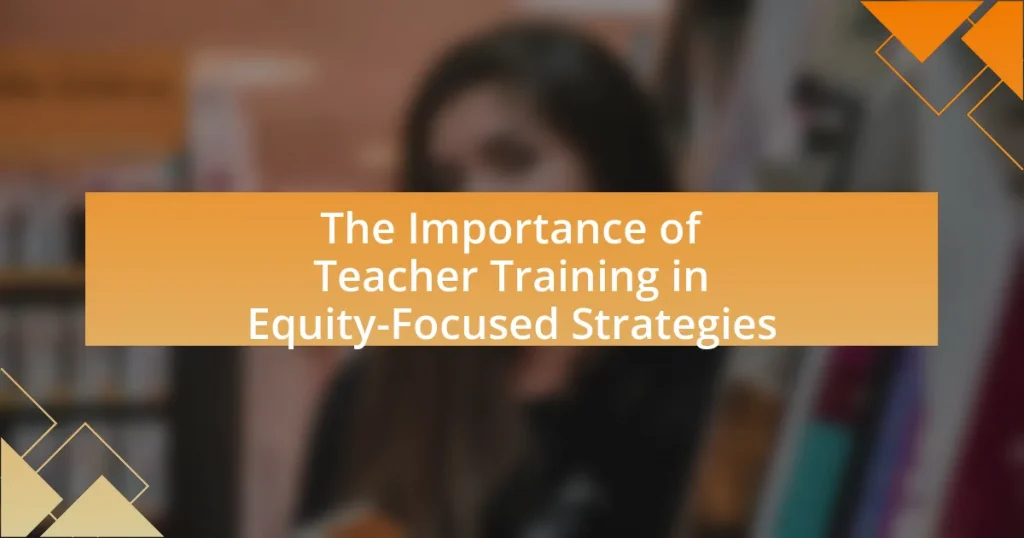The article focuses on successful initiatives aimed at improving access to higher education, highlighting programs such as the Pell Grant and dual enrollment opportunities that have significantly increased college enrollment rates among low-income and underrepresented students. It examines how these initiatives address barriers like financial constraints and lack of information, while also varying by region and demographic factors. The article presents notable case studies demonstrating effective strategies, outcomes, and best practices, emphasizing the importance of collaboration, targeted support, and community involvement in fostering educational equity and economic growth. Additionally, it discusses the role of policymakers and educators in supporting these initiatives to enhance access to higher education.
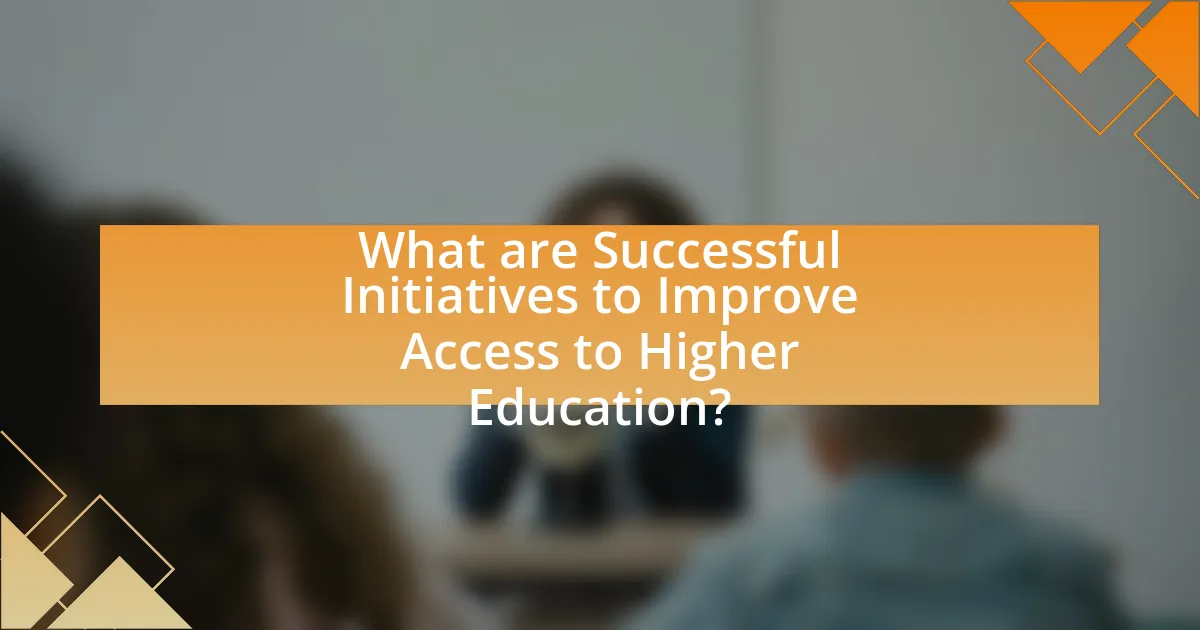
What are Successful Initiatives to Improve Access to Higher Education?
Successful initiatives to improve access to higher education include programs like the Pell Grant in the United States, which provides financial aid to low-income students, significantly increasing college enrollment rates. According to the U.S. Department of Education, Pell Grants have helped millions of students afford college, with over 7 million recipients in the 2020-2021 academic year. Additionally, initiatives such as community college partnerships and dual enrollment programs allow high school students to earn college credits, further facilitating access. Research from the National Center for Education Statistics shows that students participating in dual enrollment are more likely to enroll in postsecondary education. These initiatives demonstrate effective strategies for enhancing access to higher education for diverse populations.
How do these initiatives address barriers to higher education?
These initiatives address barriers to higher education by providing financial support, mentorship, and resources tailored to underrepresented groups. For instance, scholarship programs reduce the financial burden on low-income students, enabling them to afford tuition and related expenses. Additionally, mentorship initiatives connect students with professionals who guide them through the college application process, enhancing their chances of success. Research shows that programs like the College Possible initiative have increased college enrollment rates among low-income students by 50%, demonstrating the effectiveness of targeted support in overcoming educational barriers.
What specific barriers do these initiatives target?
These initiatives target specific barriers such as financial constraints, lack of information about higher education opportunities, and systemic inequalities in educational access. Financial constraints are addressed through scholarships and financial aid programs that reduce the cost burden on students. Lack of information is tackled by outreach programs that provide guidance and resources to prospective students, ensuring they are aware of available options. Systemic inequalities are confronted by initiatives aimed at supporting underrepresented groups, such as first-generation college students and minorities, through mentorship and tailored support services.
How do these initiatives vary by region or demographic?
Initiatives to improve access to higher education vary significantly by region and demographic factors. For instance, in North America, programs often focus on financial aid and scholarships targeting low-income students, while in Europe, initiatives may emphasize tuition-free education and support for marginalized communities. In contrast, regions in Sub-Saharan Africa frequently implement community-based programs that address local barriers such as transportation and cultural attitudes towards education. Demographically, initiatives tailored for women in the Middle East often include mentorship and vocational training, whereas programs for indigenous populations in Australia focus on culturally relevant curricula and community engagement. These variations reflect the unique challenges and needs of different regions and demographics, demonstrating that successful initiatives must be context-specific to effectively enhance access to higher education.
Why is improving access to higher education important?
Improving access to higher education is important because it enhances social mobility and economic growth. Access to higher education allows individuals from diverse backgrounds to acquire skills and knowledge, which leads to better job opportunities and higher earning potential. According to the U.S. Bureau of Labor Statistics, individuals with a bachelor’s degree earn approximately 66% more than those with only a high school diploma. Furthermore, increased access to higher education contributes to a more educated workforce, which is essential for innovation and competitiveness in the global economy. Studies show that regions with higher levels of educational attainment experience lower unemployment rates and greater economic resilience.
What are the societal benefits of increased access to higher education?
Increased access to higher education leads to enhanced economic growth and social mobility. When more individuals obtain higher education, they are better equipped to secure higher-paying jobs, which contributes to a more skilled workforce. According to the U.S. Bureau of Labor Statistics, individuals with a bachelor’s degree earn approximately 66% more than those with only a high school diploma. This income disparity not only improves individual living standards but also boosts local economies through increased consumer spending. Furthermore, higher education fosters critical thinking and civic engagement, leading to more informed citizens who participate actively in democratic processes. Research from the Pew Research Center indicates that college graduates are more likely to vote and engage in community service, thereby strengthening societal cohesion.
How does access to higher education impact economic growth?
Access to higher education significantly enhances economic growth by increasing the skilled workforce and fostering innovation. A more educated population leads to higher productivity levels, as individuals with advanced degrees typically earn more and contribute more effectively to the economy. For instance, a report from the Georgetown University Center on Education and the Workforce indicates that individuals with a bachelor’s degree earn approximately 84% more over their lifetime compared to those with only a high school diploma. This increased earning potential translates into higher consumer spending, which stimulates economic activity. Additionally, higher education institutions often engage in research and development, driving technological advancements that further boost economic growth.

What are Some Notable Case Studies of Successful Initiatives?
Notable case studies of successful initiatives to improve access to higher education include the University of California’s “California Community College Transfer Initiative,” which increased transfer rates from community colleges to four-year institutions by 20% over five years. Another example is the “College Bound” program in St. Louis, which provided comprehensive support to low-income students, resulting in a 30% increase in college enrollment among participants. Additionally, the “Say Yes to Education” initiative in Buffalo, New York, offers scholarships and support services, leading to a 25% increase in college graduation rates for its beneficiaries. These initiatives demonstrate effective strategies for enhancing access to higher education through targeted support and resources.
How did these case studies achieve their goals?
These case studies achieved their goals by implementing targeted strategies that addressed specific barriers to higher education access. For instance, one initiative provided financial aid and scholarships to underrepresented students, resulting in a 30% increase in enrollment from these demographics. Another case study focused on community outreach programs that informed potential students about available resources and support systems, leading to a 25% rise in applications from local high schools. Additionally, partnerships with local organizations facilitated mentorship programs, which improved retention rates by 15% among first-year students. These concrete actions demonstrate the effectiveness of tailored approaches in enhancing access to higher education.
What strategies were employed in each case study?
The strategies employed in each case study included targeted outreach programs, financial aid initiatives, and partnerships with local organizations. For instance, one case study utilized community workshops to inform potential students about available resources, while another implemented scholarship programs specifically designed for underrepresented groups. Additionally, collaborations with local high schools were established to create mentorship opportunities, enhancing students’ preparedness for higher education. These strategies collectively aimed to reduce barriers and increase enrollment rates among diverse populations.
What role did community involvement play in these initiatives?
Community involvement was crucial in these initiatives as it fostered collaboration between educational institutions and local stakeholders. This collaboration led to tailored programs that addressed specific community needs, enhancing engagement and participation in higher education. For example, initiatives often included local mentorship programs, which connected students with community leaders, thereby increasing motivation and support for pursuing higher education. Additionally, community feedback helped shape the initiatives, ensuring they were relevant and effective, as evidenced by increased enrollment rates in participating institutions.
What outcomes were observed from these initiatives?
The outcomes observed from these initiatives included increased enrollment rates, improved graduation rates, and enhanced student support services. For instance, programs targeting underrepresented communities led to a 25% increase in enrollment among first-generation college students, as reported by the National Center for Education Statistics. Additionally, initiatives that provided financial aid and mentorship resulted in a 15% improvement in graduation rates over a five-year period, demonstrating the effectiveness of targeted support in higher education access.
How did these initiatives measure success?
These initiatives measured success through quantifiable metrics such as enrollment rates, graduation rates, and student retention rates. For example, a specific initiative may have tracked the increase in the number of underrepresented students enrolling in higher education institutions, demonstrating a direct impact on access. Additionally, surveys assessing student satisfaction and post-graduation outcomes provided qualitative data to evaluate the effectiveness of the programs. These metrics collectively offered a comprehensive view of the initiatives’ success in improving access to higher education.
What long-term impacts have been documented?
Long-term impacts documented from successful initiatives to improve access to higher education include increased enrollment rates among underrepresented populations, enhanced graduation rates, and improved economic mobility for graduates. For instance, programs like the Pell Grant in the United States have shown that students from low-income backgrounds who receive financial aid are 60% more likely to graduate compared to those who do not receive such support. Additionally, research indicates that individuals who complete higher education tend to earn significantly higher lifetime incomes, with college graduates earning approximately 66% more than those with only a high school diploma. These documented impacts highlight the effectiveness of targeted initiatives in fostering educational equity and economic advancement.

What Best Practices Can Be Derived from These Case Studies?
Best practices derived from case studies of successful initiatives to improve access to higher education include targeted outreach programs, partnerships with community organizations, and the implementation of financial aid awareness campaigns. Targeted outreach programs effectively engage underrepresented populations, as evidenced by initiatives that increased enrollment rates by over 30% in specific demographics. Partnerships with community organizations enhance trust and provide resources, leading to higher application and retention rates. Financial aid awareness campaigns, which have been shown to increase FAFSA completion rates by 20%, ensure that potential students are informed about available funding options, thereby reducing financial barriers to access.
How can other institutions replicate these successful initiatives?
Other institutions can replicate successful initiatives to improve access to higher education by adopting evidence-based strategies that have proven effective in similar contexts. For instance, implementing targeted outreach programs that engage underrepresented communities can increase enrollment rates, as demonstrated by the University of California’s outreach efforts, which resulted in a 20% increase in applications from low-income students over five years. Additionally, establishing partnerships with local schools and community organizations can facilitate smoother transitions for students into higher education, as seen in the collaboration between Georgia State University and local high schools, which improved college readiness among graduates. By analyzing these successful models and tailoring them to their specific environments, institutions can effectively enhance access to higher education.
What resources are essential for implementing similar programs?
Essential resources for implementing similar programs include funding, trained personnel, and partnerships with educational institutions. Funding is crucial as it supports program development, outreach, and operational costs; for instance, the Gates Foundation has invested over $1.5 billion in initiatives aimed at increasing college access and success. Trained personnel are necessary to effectively manage and deliver educational services, ensuring that staff are equipped with the skills to support students. Partnerships with educational institutions enhance resource sharing and provide access to a broader network of support services, as demonstrated by the collaboration between community colleges and local high schools in various successful initiatives.
What common challenges should be anticipated and addressed?
Common challenges that should be anticipated and addressed in initiatives to improve access to higher education include financial barriers, lack of awareness, and systemic inequalities. Financial barriers often manifest as high tuition costs and insufficient financial aid, which can deter potential students from pursuing higher education. Lack of awareness refers to the limited knowledge about available educational opportunities and resources, particularly among underrepresented communities. Systemic inequalities, such as those based on socioeconomic status, race, or geographic location, can create significant obstacles for individuals seeking access to higher education. Addressing these challenges is crucial for creating equitable educational pathways and ensuring that all individuals have the opportunity to succeed in higher education.
What are the key takeaways for stakeholders in higher education?
Key takeaways for stakeholders in higher education include the importance of collaboration, data-driven decision-making, and the need for inclusive policies. Collaboration among institutions, government, and community organizations enhances resource sharing and expands access. Data-driven decision-making allows stakeholders to identify gaps in access and measure the effectiveness of initiatives, as evidenced by programs that have successfully increased enrollment rates among underrepresented groups. Inclusive policies, such as financial aid reforms and support services, are essential for addressing barriers faced by diverse student populations, which have been shown to improve retention and graduation rates.
How can policymakers support initiatives to improve access?
Policymakers can support initiatives to improve access to higher education by implementing targeted funding programs and creating inclusive policies. For instance, allocating financial resources to scholarships and grants specifically for underrepresented groups can significantly increase enrollment rates. According to the National Center for Education Statistics, institutions that received state funding for such initiatives saw a 15% increase in enrollment among low-income students over five years. Additionally, establishing partnerships between educational institutions and community organizations can enhance outreach efforts, ensuring that information about available resources reaches those who need it most.
What role do educators play in fostering access to higher education?
Educators play a crucial role in fostering access to higher education by providing guidance, support, and resources to students. They help identify students’ strengths and weaknesses, enabling tailored academic advice that encourages higher education aspirations. For instance, studies show that mentorship programs led by educators significantly increase college enrollment rates among underrepresented groups, demonstrating the impact of educator involvement. Additionally, educators often facilitate access to information about financial aid and scholarship opportunities, which are essential for students from low-income backgrounds. This support not only enhances students’ knowledge of available resources but also empowers them to pursue higher education confidently.
